Clients, services, and outcomes
Specialist homelessness agencies provide a wide range of services to assist those who are homeless or at risk of homelessness, ranging from general support and assistance to immediate crisis accommodation. This section outlines the characteristics of all clients assisted by specialist homelessness agencies in 2014–15, describes their needs for assistance and the services they received. It also provides some key trends for the 4 years from 2011–12 (the start of the Specialist Homelessness Services Collection—SHSC) to 2014–15.
Clients: trends over time
Between 2011–12 and 2014–15, specialist homelessness agencies provided support to over 650,000 clients. The estimated number of clients assisted by agencies each year has increased from 236,000 in 2011–12 to 256,000 in 2014–15. This represents an average annual growth rate of 2.6%.
Because SHSC data provide a measure of the service response, increases in client numbers generally reflect the increased availability and accessibility of services rather than change in the underlying level of homelessness in Australia. The rate of specialist homelessness service use has remained relatively steady since the start of the collection in 2011–12 (Table 1).
The characteristics of clients, the main reasons for seeking support, and the services provided to clients, have remained relatively stable over the 4 years. There have, however, been some notable changes:
- The proportion of clients who were identified as needing assistance to sustain tenancy or prevent tenancy failure or eviction increased from 28% in 2011–12 to 33% in 2014–15.
- The proportion of males who were homeless on presentation decreased from 56% of males in 2011–12 to 51% in 2014–15. The proportion of females who were homeless on presentation remained steady, at 36% of females in 2011–12 and 37% in 2014–15.
- From 2011–12 to 2014–15 there has been a small but steady increase each year in the proportion of clients aged over 45 years. In 2014–15 nearly 1 in 5 clients (19%, or nearly 48,000) were aged over 45 years. The largest average annual rate increase was reported in the 65+ age group (6.0% per year).
- The proportion of clients ending support in some form of private housing increased from 39% in 2011–12 to 43% in 2014–15.
- The proportion of clients ending support having achieved no case management goals has decreased.
| 2011–12 | 2012–13 | 2013–14 | 2014–15 | |
|---|---|---|---|---|
| Number of clients | 236,429 | 244,176 | 254,001 | 255,657 |
| Rate (per 10,000 population) | 106 | 108 | 110 | 109 |
| Housing situation at the beginning of first support period (all clients) | ||||
| Homeless: At risk of homelessness | 41%: 59% | *43%: 57% | *42%:58% | 43%: 57% |
| Living arrangement | ||||
| Lone person | 31% | 32% | 30% | 29% |
| Sole parent | 31% | 31% | 33% | 34% |
| Couple with child/ren | 13% | 13% | 13% | 13% |
| Couple without child/ren | 6% | 6% | 5% | 5% |
| Other family | 12% | 11% | 11% | 12% |
| Other group | 7% | 7% | 7% | 7% |
| Main reason for seeking assistance (Top 3) | ||||
| Domestic and family violence | 25% | 23% | 24% | 25% |
| Housing crisis | 13% | 15% | 16% | 21% |
| Financial difficulties | 15% | 16% | 15% | 12% |
| Proportion receiving accommodation, total nights accommodation (median) | 36% 6.8 million (35) |
36% 7.0 million (34) |
34% 7.0 million (35) |
33% 6.6 million (34) |
| Reasons support period ended (Top 3) | ||||
| Immediate needs met/ goals achieved | *49% | 53% | 53% | 54% |
| No longer requested assistance | *30% | 28% | 28% | 25% |
| Lost contact | 10% | 10% | 10% | 11% |
| Most common housing situation after support | ||||
| Private housing | n.a. | 39% | 42% | 43% |
| Social housing | n.a. | 21% | 21% | 22% |
| Short-term accommodation | n.a. | *20% | 17% | 16% |
| Average (median) length of support (days) | 79 (29) | 84 (31) | 81 (33) | 76 (33) |
| Achievement of case management goals | ||||
| All goals met | 22% | 22% | *24% | 26% |
| Some goals met | 69% | 71% | *70% | 68% |
| No goals met | 10% | 7% | 6% | 6% |
n.a. Not available
Notes
-
Rates are crude rates based on the Australian estimated resident population (ERP) at 30 June of the reference year.
-
* Indicates where previously published data have been revised to ensure consistent reporting over time.
-
The denominator for the proportion achieving all, some or no case management goals is the number of client groups with a case management plan (supplementary table CLIENTS.26). Denominator values for proportions are provided in the relevant national supplementary table.
Source: Specialist homelessness services annual reports 2011–12, 2012–13, 2013–14 and 2014–15.
Support periods
Data collected by specialist homelessness agencies are based on support periods, or episodes of assistance provided to clients (see Technical information for further details). Clients may have had more than one support period in 2014–15, either with the same agency at different times, or with different agencies.
- In 2014–15, clients assisted by homelessness agencies were supported in 437,004 support periods. The number of support periods has increased by an average of 4% each year since the collection began in 2011–12.
- The majority of clients in 2014–15 had only 1 support period (68%), while 18% had 2 support periods, 7% had 3 periods and 7% had 4 or more. The number of support periods per client is consistent with the previous year.
- The majority of support periods opened and closed in 2014–15 (77%, or nearly 336,000). An additional 12% of support periods opened during the year and remained open on 30 June 2015. Just 1.5% remained open throughout the entire year (Figure CLIENTS.1).
Figure CLIENTS.1: Support periods, by indicative duration over the reporting period, 2014–15
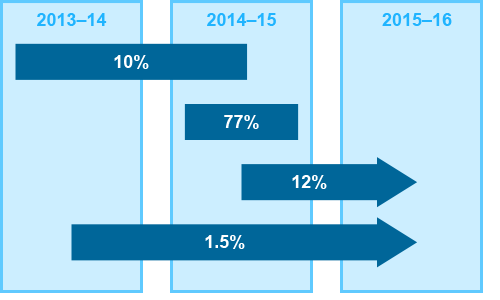
Source: Specialist homelessness services 2014–15, National supplementary table CLIENTS.19 (702KB XLS).
Number of days clients received support
- In 2014–15, clients were supported for an average of 76 days in total, either as consecutive days or over multiple periods of support. While this is a reduction in the average number of support days compared with 2013–14 (81 days), the median number of support days in 2014–15 was the same as last year (33 days).
- Males and females received a similar length of support on average (77 days for females and 75 days for males).
- About one third of clients (31%, or about 78,000) received between 6 and 45 days of support during the year; twenty-six per cent received support for 5 or less days. Fourteen per cent received over 180 days of support during 2014–15; a similar proportion received support for 91–180 days.
Reasons that support periods ended
- Around half (54%) of support periods ended in 2014–15 because the client's immediate needs were met or case management goals were achieved.
- A quarter (25%) ended because clients no longer requested assistance.
- A further 12% closed because the client was referred to another specialist homelessness agency and another 11% closed because contact was lost with the client (Figure CLIENTS.2).
Figure CLIENTS.2: Clients with any closed support period, by reason support period ended (Top 6), 2014–15
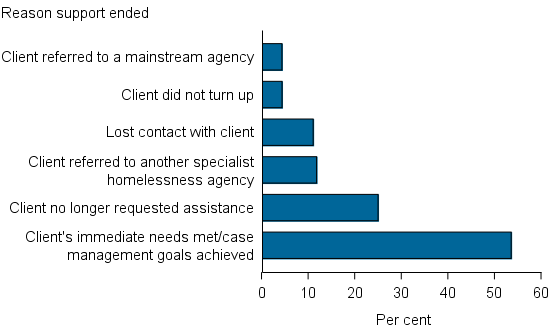
Note: Top 6 excludes 'Other' reason.
Source: Specialist homelessness services 2014–15, National supplementary table CLIENTS.21 (702KB XLS).
Characteristics of clients
In 2014–15, specialist homelessness agencies provided assistance to an estimated 255,657 clients, equivalent to 109 clients per 10,000 Australians (Table CLIENTS.2). This represents a small decrease since 2013–14, from 110 clients per 10,000.
Age and sex
6 in 10
clients were female.
- The majority (59%) of clients in 2014–15 were female (almost 152,000 clients), and 41% were male. This was a rate of 129 per 10,000 females in the Australian population receiving specialist homelessness services, and 89 per 10,000 males.
- More than one-quarter of clients were aged under 18 (just over 70,000 clients) and 16% were aged under 10 (about 42,000 clients). Over half of all clients were aged 18–44 (54%) with the largest group being 25–34 years (19%) (Figure CLIENTS.3).
- Females aged 18–24 years continue to have the highest rate of service use, at 244 per 10,000 females.
- For males the highest rate of service use was children in the youngest age group (0–9 years, 137 per 10,000 males).
Figure CLIENTS.3: Clients, by age and sex, 2014–15
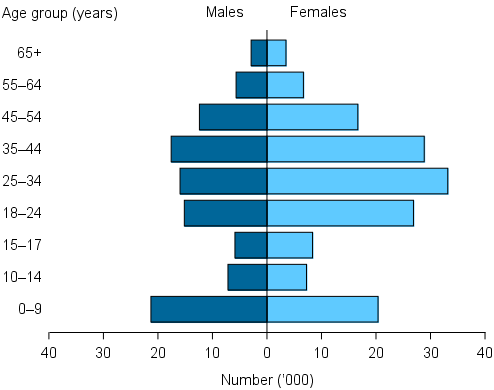
Source: Specialist homelessness services 2014–15, National supplementary table CLIENTS.1 (702KB XLS).
Indigenous status
1 in 4
clients were Indigenous.
- Aboriginal and Torres Strait Islander people continue to be over-represented among specialist homelessness services clients, with almost one-quarter of clients (23%, or just over 53,000) who provided information on the Indigenous status identified as being of Aboriginal and/or Torres Strait Islander origin. By comparison, 3% of the population identify as Aboriginal and Torres Strait Islanders [1].
- Further information about Indigenous clients can be found in Indigenous clients.
State and territory of clients
- The largest number of clients was in Victoria (102,793), followed by New South Wales (48,262) and Queensland (44,213) (Table CLIENTS.2).
- Nationally the number of SHS clients was similar to last year. Increases in client numbers in Victoria (3%, or 2,901) and Western Australia (7%, or 1,584) were offset by reductions in client numbers in New South Wales (7%, or 3,524). These results have been affected by changes in NSW data in 2014–15 and, as outlined in the Data Quality Statement, caution should be used when making comparisons with past years’ figures for NSW or with data for other states and territories.
- Nationally there have been large decreases in the total numbers of both support days and accommodation nights compared with 2013–14. There were nearly 1 million fewer days of support and over 400,000 fewer nights accommodation in 2014–15. Reporting of the number of days of support and accommodation nights have been largely affected by the major transition period for NSW Specialist Homelessness Services in 2014–15, as outlined in the Data Quality Statement. Caution should be used when making comparisons with past years’ figures for NSW or with data for other states and territories.
- The highest rates of estimated service use occurred in the Northern Territory (where there were 312 clients per 10,000 people), Victoria (176 clients per 10,000 people) and Tasmania (142 clients per 10,000 people) (Figure CLIENTS.4).
- Females had higher rates of service use than males in all states and territories. The Northern Territory had the most pronounced difference between males and females, where 429 per 10,000 females received services compared with 208 per 10,000 males (Table CLIENTS.2).
Figure CLIENTS.4: Client service use per 10,000 population, by state and territory, 2014–15
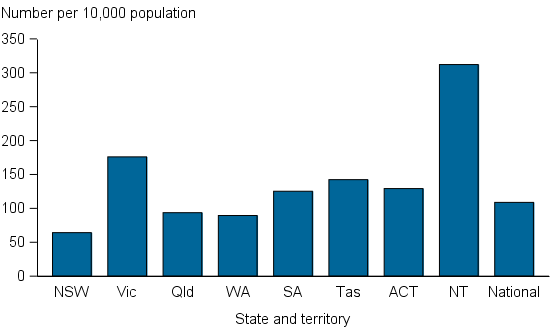
Note: Rates are crude rates as detailed in Technical information.
Source: Specialist homelessness services 2014–15, National supplementary table CLIENTS.2 (702KB XLS).
Country of birth
- Most clients of specialist homelessness agencies were born in Australia (85%, or just over 187,000) (Table CLIENTS.3). This proportion is higher than the broader Australian population, of whom 72% are born in Australia [2].
- Of those clients who reported their country of birth and were born overseas, the most common country of birth was New Zealand (13%) (Table CLIENTS.4). Nearly half of the clients (48%) who were born overseas had arrived in Australia before 2006 (Table CLIENTS.5).
Living arrangements
'One parent with 1 or more children' was the most common living arrangement (34%, or just over 79,000), followed by 'lone persons' (29%, or nearly 68,000) and couples with a child or children (13%, or nearly 32,000) (Figure CLIENTS.5).
Figure CLIENTS.5: Clients, by living arrangement, 2014–15
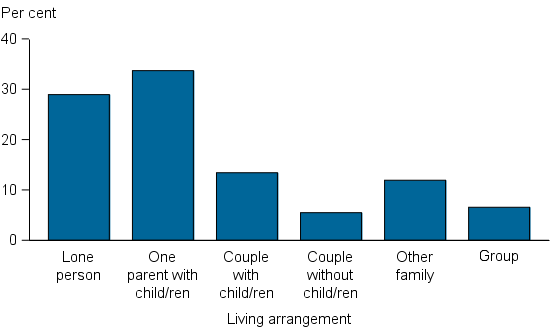
Source: Specialist homelessness services 2014–15, National supplementary table CLIENTS.6 (702KB XLS).
Housing situation
- Among those whose housing status at the beginning of their first support period was known in 2014–15 (89% of clients), 43% (98,500 clients) were homeless and 57% (130,000 clients) were classified as at risk of homelessness (Figure CLIENTS.6).
- For those clients who first presented to an agency reporting no shelter/improvised dwelling ('rough sleepers') (23,000 clients), 46% were sleeping in no dwelling, either on the street, park or out in the open and just over 1 in 5 were sleeping in a car (22%).
Figure CLIENTS.6: Clients, by housing situation at the beginning of support (Top 6), 2014–15
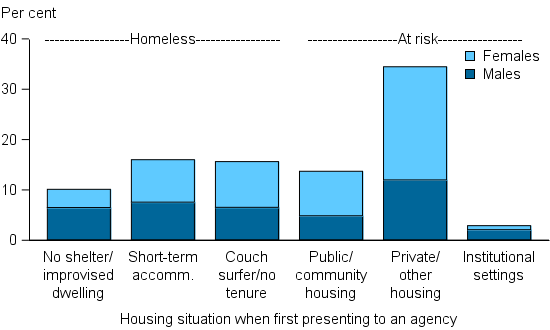
Note: Per cent calculations based on Total clients, excluding 'Not stated'.
Source: Specialist homelessness services 2014–15, National supplementary table CLIENTS.7 (702KB XLS).
Source of referral
- In 2014–15, 65%, or nearly 163,000 clients, were formally referred to a specialist homelessness agency.
- Figure CLIENTS.7 shows that the most common referral source was by either another specialist homelessness agency or outreach worker, (12%) or other agency (12%), followed by the police (9%).
Figure CLIENTS.7: Clients, by source of referral (Top 6), 2014–15
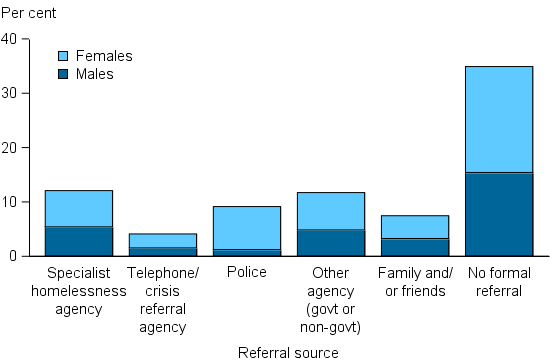
Note: Top 6 excludes formal referral source 'Other'.
Source: Specialist homelessness services 2014–15, National supplementary table CLIENTS.9 (702KB XLS).
Main source of income
- A high proportion of clients aged 15 and over was receiving some form of government payment at the time they sought support. The most common government payments were Newstart Allowance (27%, or nearly 46,000), Parenting Payment (19%, or about 32,000) and Disability Support Pension (17%, or about 29,000).
- A total of 7% reported income from employment and 9% of clients reported having no income.
Education
- Sixteen per cent of clients aged 5–14 (about 4,500) were not enrolled in education—the largest proportion was aged 5 (38%).
- About half of young people aged 5–24 (53%, or nearly 41,000) were enrolled in education.
- Among those clients aged over 25, 4% were enrolled in some form of education—mostly vocational education or training.
- Twenty-nine per cent of clients aged 15–24 were not in some form of education or employment.
Labour force
- The proportion of clients not in the labour force at the beginning of support in 2014–15 was slightly lower than that of clients in 2013–14 (45% and 47%, respectively) (Figure CLIENTS.8).
- About 73,300 (45%) clients aged 15 or over were unemployed at the beginning of support.
- Eleven per cent of clients were employed; of these, 2 out of 3 were employed on a part-time basis.
- The main differences between male and female clients were that females were more likely to report not being in the labour force (48% females and 39% males); however, females were also more likely to be employed than males (12% compared with 8%).
Figure CLIENTS.8: Clients aged 15 and over, by labour force status at the beginning of support, 2014–15
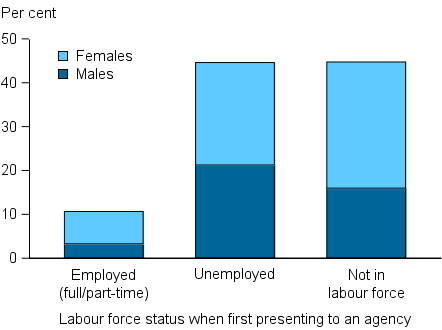
Source: Specialist homelessness services 2014–15, National supplementary table CLIENTS.12 (702KB XLS).
Clients' needs for assistance and services provided
In the SHSC, information is captured about clients' needs for services from 2 perspectives:
- The client's reasons for seeking assistance are captured at the start of support—both main reason for seeking support and all reasons for seeking support are collected.
- The agency worker's assessment of the client's needs—this information is captured when clients first present for assistance and each month while a client is still in contact with the agency.
Technical information and glossary provides more information about how clients' needs for assistance are captured in the SHSC. Services provided to clients range from the direct provision of accommodation, such as a bed in a shelter, to specialised services such as financial counselling. These services are generally either provided by the agency or referred to another service. Unmet demand provides further information about clients' needs that went unmet.
Reasons for seeking assistance
- Over half of clients (54%, or over 136,000) identified accommodation as a reason for seeking assistance, an increase of 5% from 2013–14.
- Housing crisis was identified by 39% of clients as a reason for seeking assistance (Figure CLIENTS.9).
- Just over 60% of clients identified housing affordability stress or financial difficulties as a reason for seeking assistance.
- Half of all SHS clients (about 126,000) identified interpersonal relationships as a reason for seeking support; within this group domestic and family violence and/or relationship/family breakdown were identified for 55% of clients.
- Health issues remain one of the common reasons clients seek assistance. Mental health, medical issues or problematic substance use were recorded as one of the reasons for seeking assistance for 21% of clients.
- Lack of family or community support was one of the reasons for seeking support for 17% of clients.
In 2014–15 changes occurred in the way agencies are required to report 'reasons for seeking assistance' and 'main reason'. Comparisons over time should be made with caution as the reporting of housing crisis, financial difficulties and housing affordability stress may be inconsistent between agencies. See Technical information for further details.
Figure CLIENTS.9: Clients, by all reasons for seeking assistance (Top 6), 2014–15
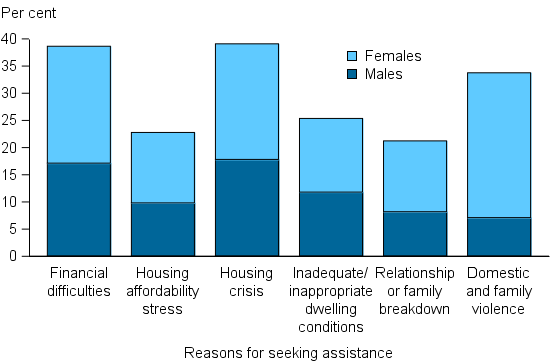
Source: Specialist homelessness services 2014–15, National supplementary table CLIENTS.13 (702KB XLS).
While clients can identify a number of reasons for seeking assistance, agencies also record the main reason for seeking assistance.
- Domestic and family violence was identified as the main reason for seeking assistance (Figure CLIENTS.10) for one quarter of clients (about 64,000). For more information see Clients experiencing domestic and family violence.
- Housing crisis was reported by 21% of clients as the main reason for seeking assistance.
To aid interpretation of data on main reason for seeking assistance see Technical information for details on changes in agency reporting in 2014–15.
Figure CLIENTS.10: Clients, by main reason for seeking assistance (Top 6), 2014–15
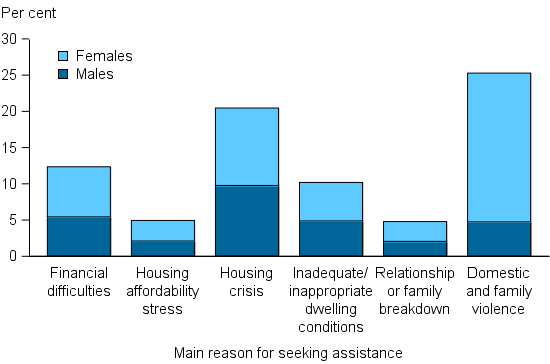
Source: Specialist homelessness services 2014–15, National supplementary table CLIENTS.14 (702KB XLS).
General support and assistance
Some types of assistance provided by SHS agencies can be described as 'general support and assistance' (as opposed to more specialised services). These include advice and information, material aid, meals and living skills.
- Of all assistance needed by clients, advice and information continued to be the most common, identified as a need by 79% in 2014–15. The next most common was advocacy and liaison, needed by 55% clients, and 35% of clients needed material aid/brokerage (Figure CLIENTS.11).
- Advice/information and advocacy/liaison were provided directly by the agency for almost all clients who needed them. This differs from some specialised services (such as legal information and training or employment assistance) for which clients were more often referred to another agency.
- In 2014–15 there were about 17,000 fewer requests for assistance with meals, laundry/shower facilities, recreation and transport, and about 5,000 fewer requests for employment, training and educational assistance compared with 2013–14.
Figure CLIENTS.11: Clients, by most needed general services and service provision status (Top 10), 2014–15
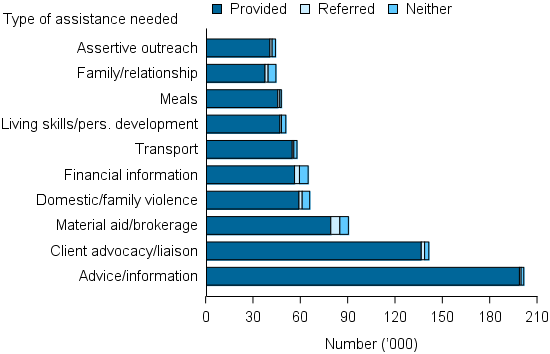
Note: Top 10 excludes 'Other basis assistance'.
Source: Specialist homelessness services 2014–15, National supplementary table CLIENTS.15 (702KB XLS).
Housing/accommodation services
Housing and accommodation services provided by agencies include:
- short-term or emergency accommodation
- medium-term/transitional housing
- long-term housing
- assistance to sustain tenancy or prevent tenancy failure or eviction.
In 2014–15 56% of SHS clients identified a need for accommodation. Of these 143,000 clients:
- 85,000 (or 60%) were provided with accommodation by the agency
- 21,000 (or 15%) were referred to another agency
- 37,000 (or 26%) were neither provided with assistance nor referred. These clients are described in Unmet demand.
The proportion of SHS clients in 2014–15 who identified a need for accommodation assistance is similar to 2013–14 (56% and 55%, respectively).
However, the proportion of these clients who were subsequently provided with accommodation has decreased in 2014–15 (60% compared with 63% in 2013–14).
Over 6.5 million nights of accommodation were provided in 2014–15, about 0.4 million fewer (or 6% less) than last year. Total nights may represent more than one period of accommodation during 2014–15 (Table CLIENTS.16) (see Technical information for details on how length of accommodation is calculated).
- On average each client received 77 nights of accommodation (median accommodation length was 34 nights).
- Most of the accommodation nights were in medium-term housing (56%) followed by short-term (37%) and long-term housing (6%).
Assistance to sustain tenancy/prevent eviction was needed by 33% of clients at some stage during their support period in 2014–15. This group includes those who were still housed when they approached an SHS agency and were supported to remain in the same house. It also includes those who identified a need for accommodation, were assisted to secure new accommodation and then supported to sustain that housing.
- Most clients (83%, or 71,000) received assistance to sustain housing directly from the specialist homelessness agency.
- There has been, on average, a 6% increase in the proportion of clients needing assistance to sustain tenancy each year since 2011–12.
Specialised services
- Health/medical services were identified as a need by 1 in 10 clients (or 25,700 clients) and was one of the services most often referred (26%) (Figure CLIENTS.12).
- There has been little change in the most common specialised services needed and provided over the last 4 years.
Figure CLIENTS.12: Clients, by most needed specialised services and service provision status (Top 10), 2014–15
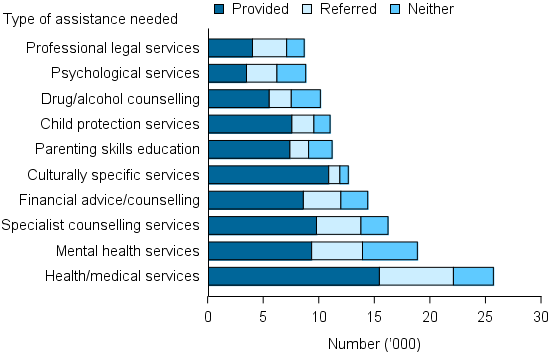
Note: Excludes 'Other specialised service'.
Source: Specialist homelessness services 2014–15, National supplementary table CLIENTS.15 (702KB XLS).
Financial assistance
- A total of $24.4 million in financial assistance was provided to clients in 2014–15 (Figure CLIENTS.13), a similar amount in nominal terms to the previous 2 financial years.
- Three quarters of the financial assistance was used to assist clients with housing:
- Around half (49%, or $12.0 million) of the financial assistance was used to assist clients to establish or maintain a tenancy.
- A quarter of this funding (26%, or $6.5 million) was used to provide short term or emergency accommodation.
- These funding proportions are consistent with expenditure patterns in 2013–14.
- The average total amount of assistance provided was $468 per client who received financial assistance.
While payments for training/education/employment make up less than 2% of financial assistance, the amount provided for these purposes has decreased over the 4 years of the collection; in nominal terms, on average there has been a 3.8% decrease in assistance funding each year.
Figure CLIENTS.13: Total amount of financial assistance provided to clients, by payment type, 2014–15
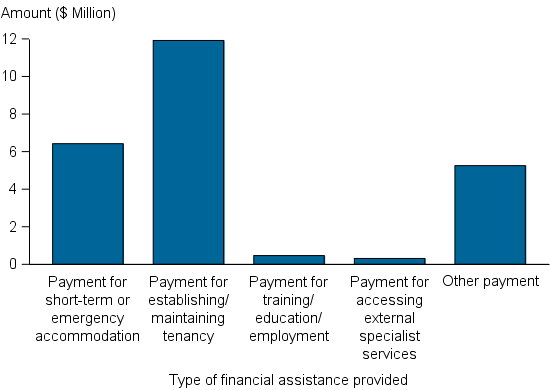
Source: Specialist homelessness services 2014–15, National supplementary table CLIENTS.17 (702KB XLS).
Outcomes following support
This section looks at clients who ceased receiving support in the year—their support periods had closed and they did not have ongoing support at the end of the year. The outcomes presented here are changes in clients' situations with reference to the start and end of support. Many clients had long periods of support or multiple support periods during the year and they may have had a number of changes over the course of their support (for example, their housing situation may change a number of times during support). These changes within the year are not reflected here.
- Clients whose support period both opened and closed in 2014–15 accounted for 77% of all clients (Figure CLIENTS.1). A proportion of these clients may seek assistance again in 2015–16.
Housing outcomes
Three aspects of a client's housing situation are considered in their housing circumstances: dwelling type, housing tenure, and the conditions of occupancy. See Technical information for details on these categories and their derivation.
- In 2014–15, the proportion of clients who were considered homeless reduced from 43% at the start of support to 33% at the time of their last contact with the agency. This reduction was due to large decreases in both the proportion of clients with either no shelter or living in improvised dwellings (from 11% to 6%) and in the proportion of clients living in a house, townhouse or flat as a 'couch surfer' with no tenure (from 16% to 11%).
- By comparison, there was an increase in some forms of tenure over the course of support, including a large increase in the proportion of clients living in public or community housing (from 15% to 22%) (Figure CLIENTS.14).
These trends demonstrate that by the end of support, many clients have achieved or progressed towards more stable housing.
Figure CLIENTS.14: Clients with closed support, by housing situation at beginning of support and at end of support, 2014–15
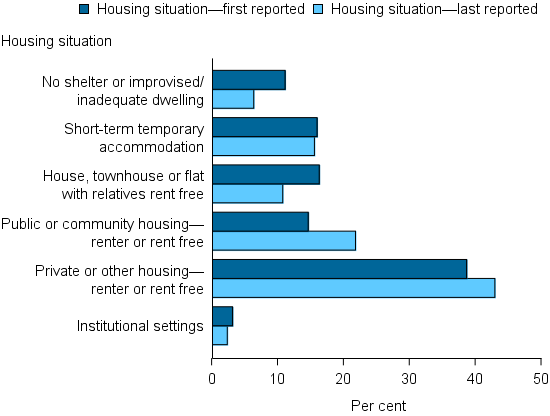
Note: Per cent calculations based on Total clients, excluding 'Not stated/other'.
Source: Specialist homelessness services 2014–15, National supplementary table CLIENTS.22 (702KB XLS).
Other outcomes for clients
Specialist homelessness agencies may support clients in a number of areas to reduce their vulnerability to homelessness. Outcomes include changes in educational enrolment status, labour force status and main source of income.
Education
- For clients with closed support, there was little change in the proportion of clients enrolled in education/training, from the beginning of support to the end of support (approximately 21%).
- Among those who also had an identified need for support relating to education or training assistance, 39% were enrolled in education/training at the beginning of support, and this increased to 43% at the end of support.
Employment
- Figure CLIENTS.15 shows a decrease in the proportion of clients (who had an identified need for employment assistance) who were unemployed following support (53% down from 60% at the beginning of support).
- Among those clients who had an identified need for employment assistance, the proportion of clients who were employed at the end of their support period increased from 12% to 21%.
Figure CLIENTS.15: Clients with closed support needing assistance relating to employment, by labour force status at beginning and at end of support, 2014–15
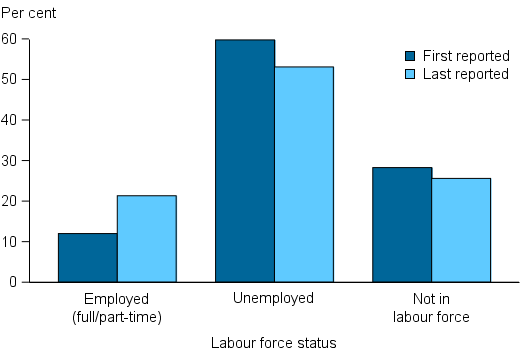
Source: Specialist homelessness services 2014–15, National supplementary table CLIENTS.24 (702KB XLS).
Income
SHS agencies often provide services to clients aged 15 and over needing assistance to obtain/maintain a government allowance or employment assistance.
- Of those who needed this type of assistance, the proportion of clients reporting having a main income source of a government payment or allowance increased from 75% at the start of support to 81% at the end of support.
- There was a reduction in those with no income (from 11% to 7%) and the proportion awaiting government benefits halved (from 7% to 3%) (Figure CLIENTS.16).
Figure CLIENTS.16: Clients with closed support needing assistance to secure an income, by main source of income at beginning and at end of support, 2014–15
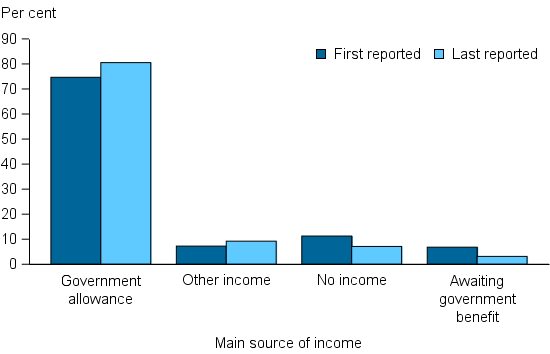
Source: Specialist homelessness services 2014–15, National supplementary table CLIENTS.25 (702KB XLS).
Achievement of case management goals
Case management plans enable agency workers to assist a client to work towards agreed goals. In some cases, support periods are too short to allow for a case management plan; in other cases, a client may decline to have a case management plan. Case management approaches can differ from jurisdiction to jurisdiction and over time as policy and practices change.
- For those clients with closed support, 60% (or 122,300 clients) had a case management plan—47% in their own right, and 13% were part of another client's case management plan. The proportion of clients with a case management plan was less than in 2013–14 (63%).
- Among those who had a plan in their own right, 68% achieved some of their case management goals, 26% achieved all their goals and 6% did not achieve any (Table CLIENTS.26). The proportion of clients achieving all their goals was considerably better than in 2013–14 (19%).
- Of the 40% of clients with closed support who did not have a case management plan, the most common reason given for not having one was that the service episode was too short (71%), while 13% did not agree to having a case management plan.
References
- Australian Bureau of Statistics (ABS), 2015a. Australian demographic statistics, Mar 2015. ABS cat no. 3101.0. Canberra: ABS.
- ABS 2015b. Migration, Australia, 2013–14. ABS cat no. 3412.0. Canberra: ABS.


